Hibiscus is a flowering plant that produces big and vibrant flowers. If you want to grow them in your garden, you need to understand their requirements. Today, I will share with you all about the light requirements of the hibiscus plant.
Being sun-loving plants, Hibiscus needs full sun for 6-8 hours daily to produce big and vibrant blooms. They can also grow in partial shade but won’t grow many flowers or have much vibrancy. Ensure not to shade them completely as that will weaken the plant and leads to wilting.
This guide will explain everything regarding the light requirements of Hibiscus. We will share the light needs of Hibiscus and the ways of dealing with poor light conditions.
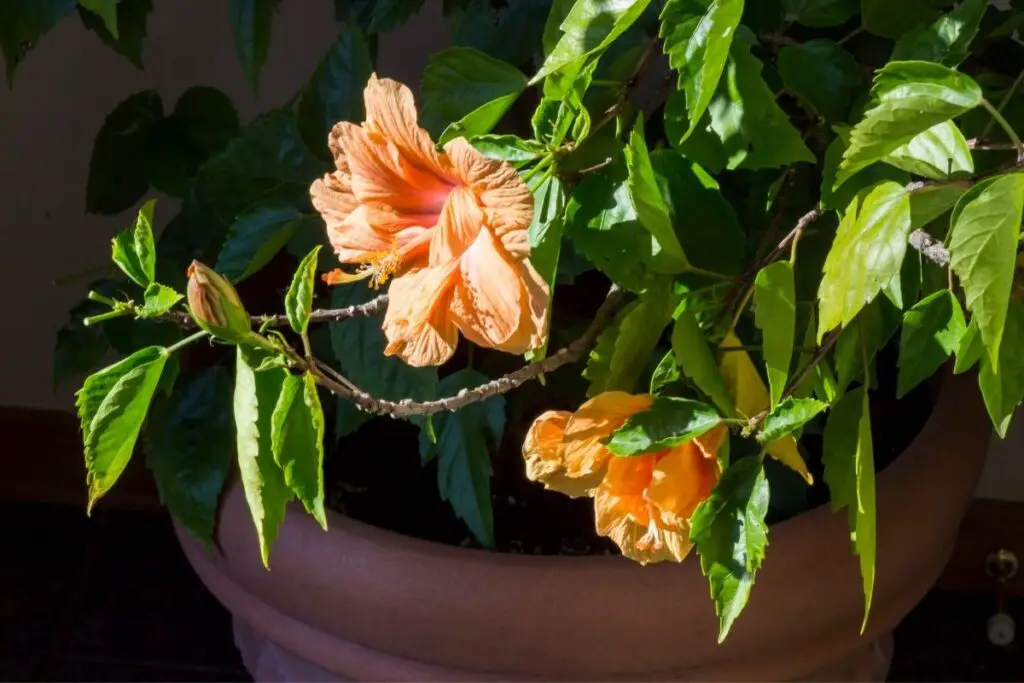
How many hours of sun does a Hibiscus plant need?
Hibiscus is a stunning flowering plant in tropical regions.
If grown in your garden, they will beautify your garden with big colorful blooms and give it a touch of elegance.
They will grow best in your garden if you maintain a tropical environment around them.
Hibiscus will need a minimum of 6 hours of sunlight daily.
It is the minimum amount.
Generally, they will grow best when they receive 6-8 hours of sun daily.
Though they don’t absorb so much sun as the Zinnias, they will grow vigorously and produce blooms if they receive full sun.
However, if you belong to hot areas that obtain sweltering summers, your Hibiscus will need protection from the direct sunlight.
The heat will get highly scorching and intense and result in sunburn.
Put on shading nets during the hottest part of the day.
You can plant them in the east-facing planting site to let them receive the direct sun of the morning.
This direction will also provide some shade in the afternoon.
Hibiscus will also grow well if they receive only 2 hours of direct sunlight daily.
With that, Hibiscus must also receive 6 to 8 hours of indirect or filtered light daily for the rest of the day.
An ample amount of sunlight will encourage blooming.
Can I grow them indoors?
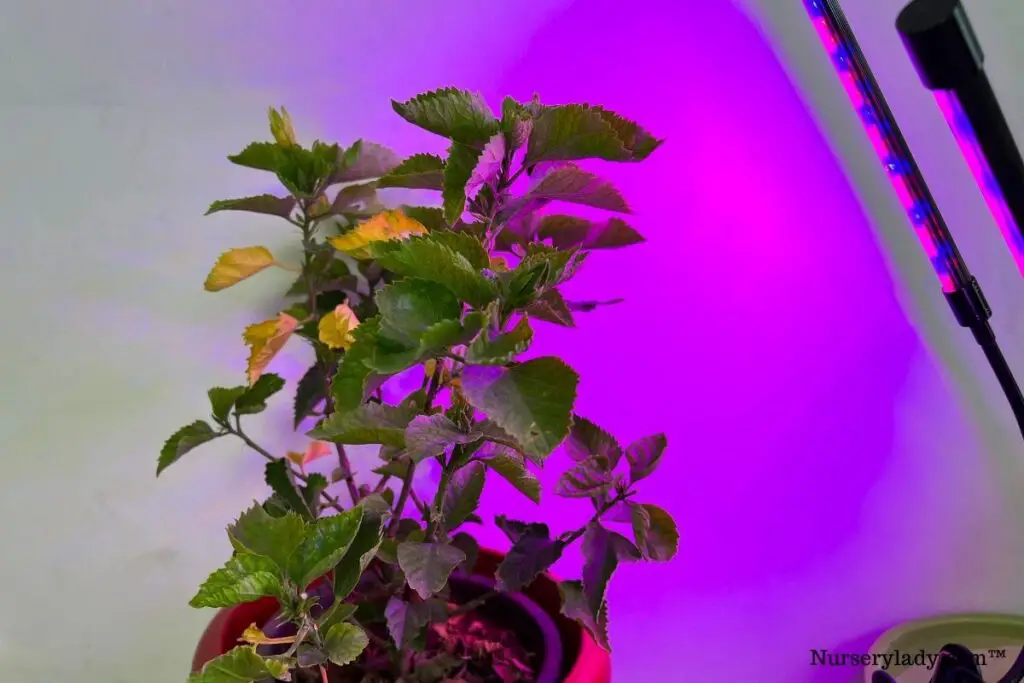
Yes, Hibiscus can be grown indoors without any hassle.
Pace them near a south or west-facing window.
During intense sun, fix shading nets.
In case of low light, fix artificial lights.
Or, let them have at least 2-3 hours of sunlight daily.
For the rest of the day, allow them to have filtered light.
Will Hibiscus tolerate full sun?
Hibiscus grow best when they receive full sun.
But that is for 6 to 8 hours daily.
The perennial Hibiscus plants enjoy consistently moist soil.
So, you must ensure that they don’t get exposed to extremely hot afternoon sun.
Indeed Hibiscus can endure full sun, but it is not the same as the sunniest area of your garden.
Such a location will also receive the harsh sun of the mid-day and afternoon.
The harsh afternoon sun will dry out the soil very quickly.
Your Hibiscus will suffer in such drought conditions.
Tropical Hibiscus also enjoys slightly moist soil, but they can tolerate droughts more than the perennials.
But not for too long.
If your garden has a sunny, moist area, plant your Hibiscus at such a location.
Also, check that the zone receives partial shade during the hottest part of the day.
Grow Hibiscus on the northern or eastern side of your garden.
Save the southern or western side for the herbs and other sun-loving and drought-tolerant plants.
Will Hibiscus grow in partial shade?
If your garden doesn’t have a spot with full sun, you can even plant the Hibiscus plants under partial shade.
But the problem is, they won’t grow as energetically as those standing under the full sun.
They might struggle a bit in growing and flowering.
In such a case, you have to shift Hibiscus to another spot of your garden that receives direct sunlight.
At least 2-3 hours of direct light is essential. For the rest of the day, partial shade is fine for them.
Some amount of shade is good if you live in a hot region.
For example, the southern parts of the US will get very high temperatures during the summers.
The sunlight gets very intense during such time.
Hibiscus will get harmed if they get exposed to such harsh sunlight.
So, they won’t mind if they are standing under a partially shady area.
Instead, this partial shade will reduce the chances of sunburns.
Bottom line, although Hibiscus enjoys a warm climate with usual summer temperatures, some shade during the hard summer days is beneficial.
Looking for gardening supplies? We have tested 100's of products before recommending them to you guys. Check out our best pick below:
| Image | Gardening Supplies | Best Price? |
|---|---|---|
 Top
Top Top
Top | Raised Garden Bed Kit | Check On Amazon |
 | XLUX Soil Moisture Meter, Plant Water Monitor, Soil Hygrometer Sensor for Gardening, Farming, Indoor and Outdoor Plants, No Batteries Required | No Results |
 Top
Top Top
Top | 82 Pcs Garden Tools Set and Extra Succulent Tools Set | Check On Amazon |
 | Joeys Garden Expandable Garden Hose with 8 Function Hose Nozzle, Lightweight Anti-Kink Flexible Garden Hoses, Extra Strength Fabric with Double Latex Core, (50 FT, Black) | No Results |
 Top
Top Top
Top | Dual Chamber Compost Tumbler | Check On Amazon |
 Top
Top Top
Top | Sunnyglade Plant Stakes | Check On Amazon |
 Top
Top Top
Top | Organic Cold Pressed Neem Seed Oil | Check On Amazon |
 Top
Top Top
Top | Mighty Mint Gallon :-Insect and Pest Control Peppermint Oil | Check On Amazon |
 Top
Top Top
Top | Scotts DiseaseEx Lawn Fungicide | Check On Amazon |
 Top
Top Top
Top | Jacks Classic 20-20-20 All Purpose Fertilizer | Check On Amazon |
 Top
Top Top
Top | 30,000 Seeds Pollinator Attracting Wildflower Mixture | Check On Amazon |
 Top
Top Top
Top | Survival Vegetable Seeds Garden Kit-Over 16,000 Seeds | Check On Amazon |
Can Hibiscus survive under shade?
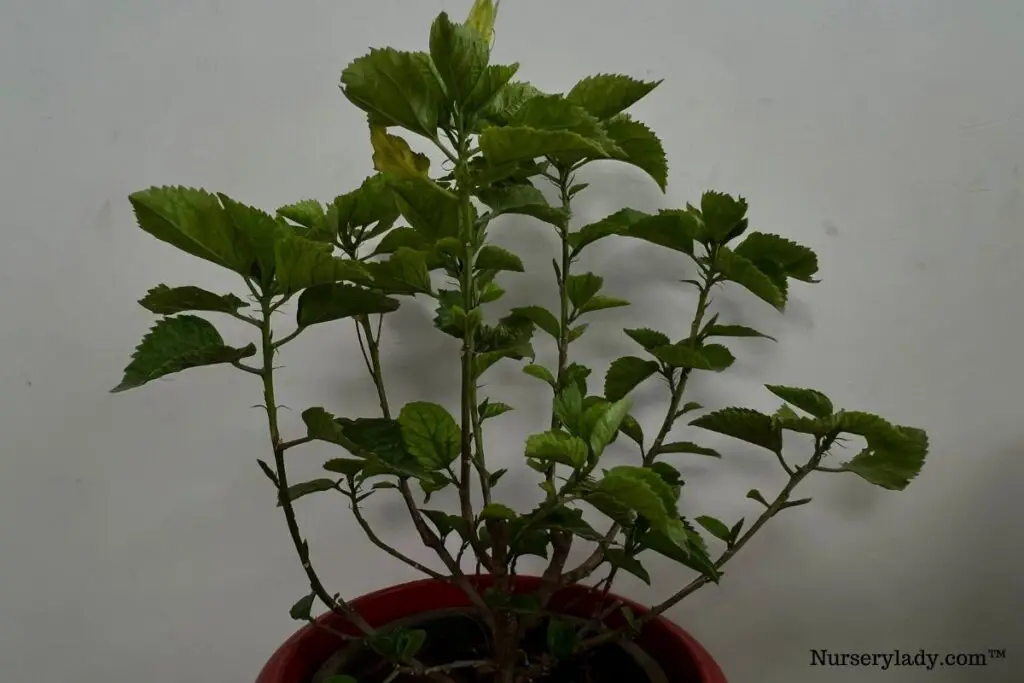
As I have explained in the previous point, Hibiscus can develop under partial shade, but they will struggle a little to grow adequately.
They might grow very few blooms or even fail to produce them.
If your plant stands in full shade, the plant will begin to wilt at first.
Then they won’t have any blooms.
Over time, the plant will eventually die.
Which direction will give Hibiscus sufficient sunlight?
For planting Hibiscus outdoors in your garden, you need to understand which direction receives full sun throughout the day in your area.
Generally, it is considered southern or western direction.
But, it will differ depending on the hemispheres.
If you live in the northern hemisphere, the Southern and Western directions will have lots of sunlight.
The Eastern side will receive direct sunlight in the morning.
As the day progresses, the sunlight will fade, and the direction will receive some shade.
The northern side will get the least sunlight.
The northern direction receives the maximum amount of sun in the southern hemisphere, provided you live near the south pole.
If you live near the equator in this hemisphere, the east and west directions get maximum sun.
The south side gets the least amount of sun.
Hibiscus will grow best when they receive full sun for 6 to 8 hours and some shade during the mid-day and afternoon when the heat intensifies greatly.
Depending on these circumstances, plant your Hibiscus in the sunniest spot of your garden.
Also, ensure some shade in that area as that would be helpful in summers.
You can plant them along or on the backside of perennial flower beds.
The same direction works with the indoor setting too.
How will Hibiscus react to too much sunlight?
Too much harsh sunlight for a long time will damage the Hibiscus plant.
Additionally, too much sunlight during high temperatures will dry out the soil fast and make the plant suffer heat stress.
Signs of too much sunlight are:
- Leaves turn yellow and wilting.
- Leaf breaking and wilted flowers
- Leaves have yellow or white blotches, signifying sunburns.
How to save the plant from too much sunlight?
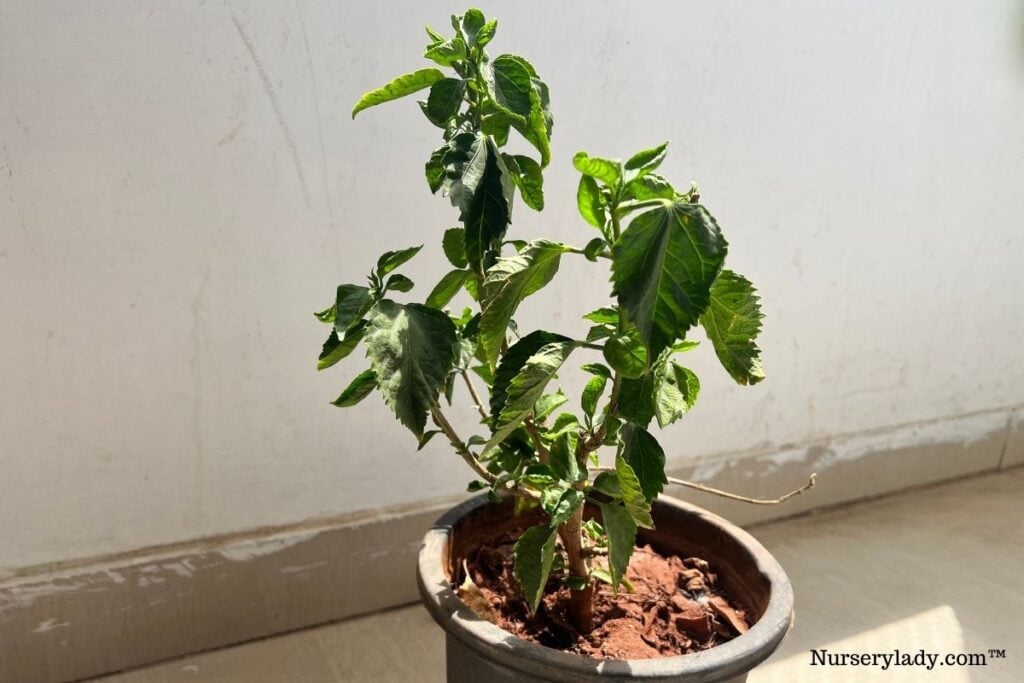
When Hibiscus gets disclosed to extremely direct sunlight, they will get damaged.
Besides, they will display some signs.
When you find those signs in your Hibiscus that get revealed to the direct sun, follow the following tips:
- Shift your plant or fix a shade
- Put on transparent shading nets to filter the light. Fix this net in the mid-day or afternoon, when the sun feels too intense.
- If your plant is in containers, shift them to a partially shady location. It will let your plant recover the damage.
- If your plant is indoors, fix sheer curtains to filter the plant. You can also move the plant some feet back from the window.
- Moving the plant away from the direct sun will prevent overheating and frequent dehydration.
Increase watering
Hot and dry weather with lengthy sunlight hours in summers dries out the soil very quickly.
Perennial Hibiscus plants are not drought-tolerant and won’t enjoy if the soil dries so often.
Although the tropical Hibiscus can tolerate it, it is not for a very long time.
You must check the soil frequently with a moisture meter to understand its moisture level, especially those exposed to the direct sunlight in your garden.
If the top 1-inch of the soil feels dry, water the plant.
Hibiscus will grow best when their soil is moist consistently and not very dry or soggy.
Dry soil will weaken the plant and kill them.
If your Hibiscus is indoors or under dappled sunlight outdoors, water it 3 to 4 times every week in summers.
In the late summers, water the plant daily.
Following this watering routine will maintain adequate moisture in the soil.
Consistently moist soil also keeps the plant cool and prevents overheating.
Mist the leaves and flowers
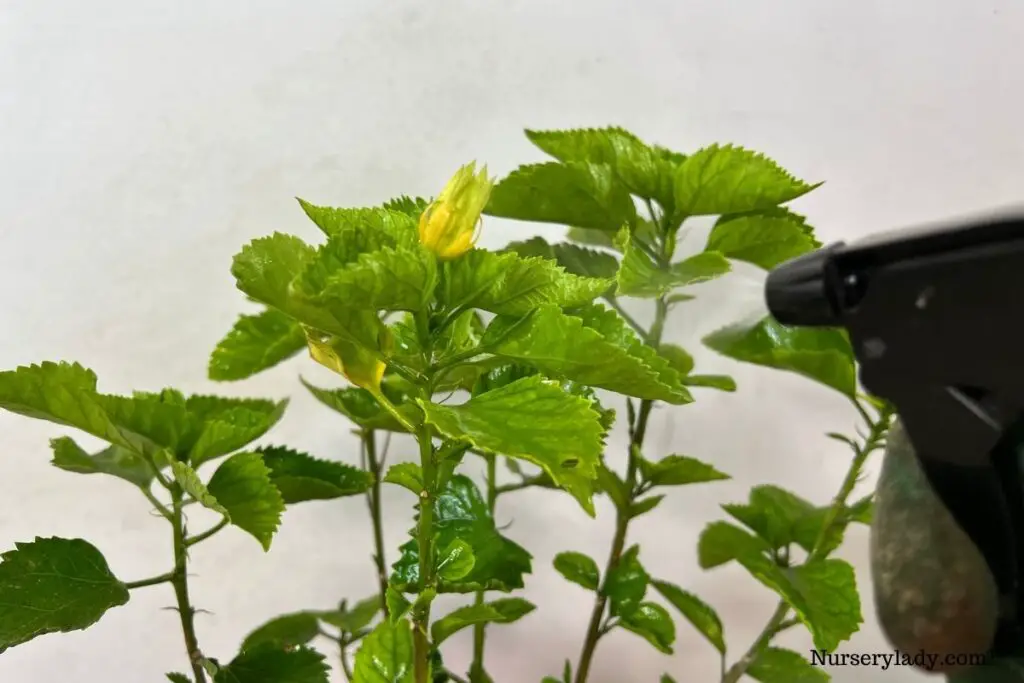
Belonging to tropical regions, Hibiscus will enjoy high humidity.
It also increases the moisture level and keeps the plant from getting dry.
Mist the leaves and the flowers with water once a week when you see the leaves are breaking or wilting.
Misting helps to create a humid environment around the Hibiscus and increases moisture in the flowers and leaves.
For the outdoor plants, use a gentle sprinkler system to mist them.
For indoor plants, use a mister bottle.
What happens if Hibiscus is not getting enough light?
As I pointed out previously, the plant will struggle to grow and flower without enough light.
Eventually, they will die if they stand under full shade for prolonged periods.
The signs of low light conditions are:
- The leaves will turn yellow at first.
- There will be no blooms in the plant.
- Low light conditions also affect the functioning of photosynthesis. As a result, the Hibiscus fails to get much food.
- The plant will become malnourished and become prone to pests and diseases.
- If still kept ignored, the plant will die eventually.
How to save the plant from such conditions?
Remember, since they were under shade for so long, a transition is necessary.
- Shift the plant to a location having partial sunlight.
- Let them have 2-3 hours of direct sunlight in the morning. For the rest of the day, protect them from the harsh sun and give them filtered sun.
- Slowly, over time, increase the timing of exposure.
- Since low light is a common problem indoors, fix artificial lights to fulfill their light requirements. You can use a 4-tube fluorescent light. Use one with a timer setting. Keep it on for 16 hours per day. Maintain a distance of 6 to 12 inches between the plant and light.
How can I differentiate direct, indirect, partial, and full sun?
You have come across words like direct sunlight, indirect sunlight, partial sun or shade, and full sun.
All the terms are confusing enough to understand, especially if you are a beginner.
But, don’t worry because we have cleared this for you.
First, let’s understand direct and indirect sunlight.
There are two ways to understand this:
- Bring your hand out in the sunlight. If the heat feels intense and the shadow is sharp, it is direct sunlight.
- If the heat feels mild and the shadow is soft, it is filtered or indirect sunlight.
Now, to distinguish between full sun and partial sunlight:
When the plant is standing under the direct sunlight for most of the time, without any shade, it is called full sunlight.
But, if half of the plant gets direct sun and the other half receives shade, it is partial sunlight.
Now that you got acquainted with the different sunlight types expose your Hibiscus under whatever condition seems good for the plant’s good growth and frequent blooming.
Geographical location will determine the light condition for Hibiscus.
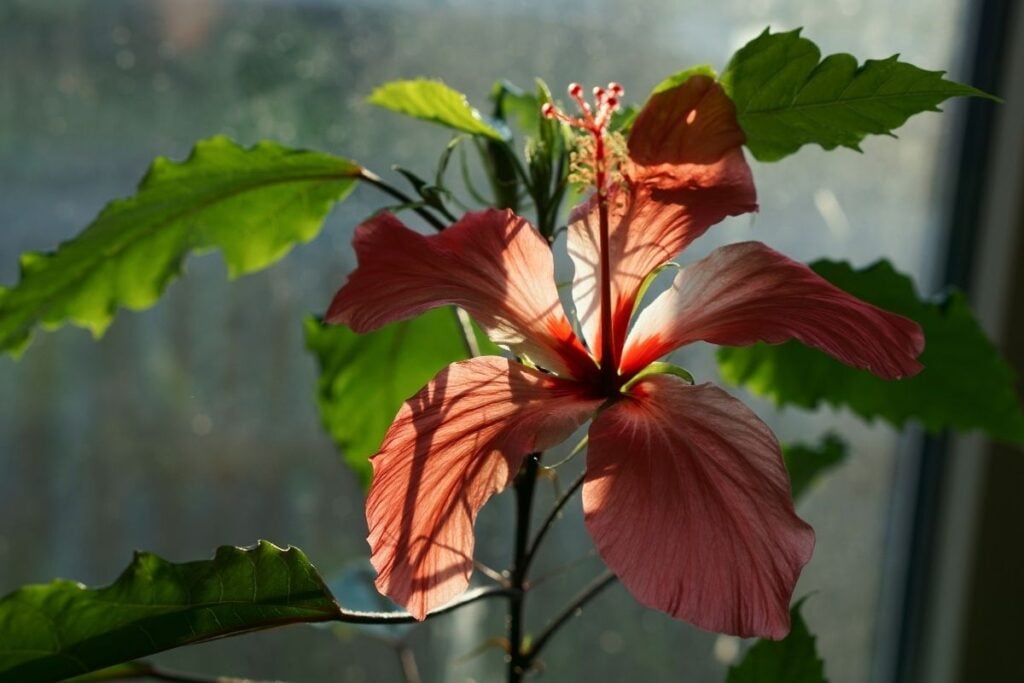
If you live in tropical areas with mild temperatures, for example, the west coast of the United States, Hibiscus will grow very well under the full sun.
If you belong to hot and dry areas, like Texas and Arizona, provide your Hibiscus with some shade in the afternoon.
If you are from hot and tropical climatic areas like Florida, it will be best to provide the Hibiscus with afternoon shade.
Though Hibiscus grows well in hot areas in their growing season, they will shed buds during the scorching climate in summer.
If you belong to an atmosphere having a desert-like environment, shade your Hibiscus in the afternoon.
It will prevent the buds from falling off and help in blooming.
Final thoughts
Providing adequate light to Hibiscus is not a very difficult job. You can fulfill their light requirements by keeping certain things in mind.
Let Hibiscus have 6 to 8 hours of direct sunlight daily. You can also grow them by providing them with only 2 hours of direct sunlight and 6 to 8 hours of filtered sun throughout the day.
Exposure to the direct sun the whole day can overheat the plant and dry out the soil faster. So, increase the water frequency to maintain the soil moisture and balance with the harsh sun and heat. Also, shade the plant.
Water them at least 3 to 4 days a week. In the late summer, water daily to prevent drought conditions. It would be best to the Hibiscus at a location that gives direct sun in the morning and shade in the afternoon.
Reference: Wikipedia, ASPCA, Louisiana State University Agricultural Center, American Society for Horticultural Science, Tropical Hibiscus by Texas A&M University, Sciencedirect.
